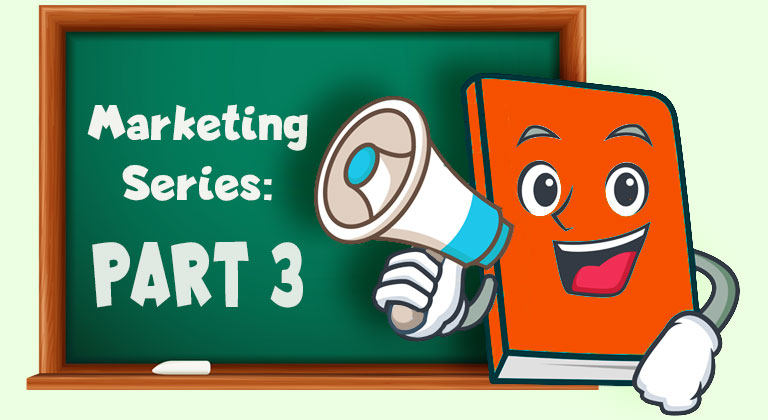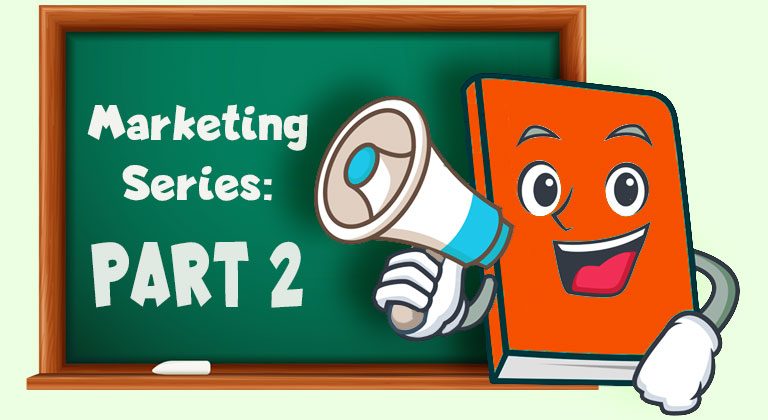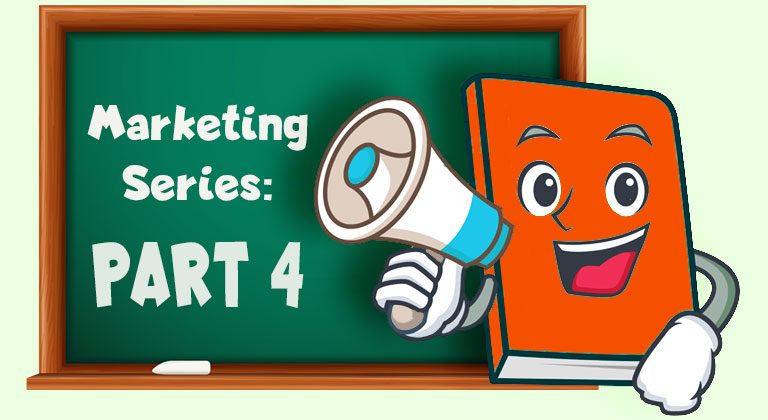Ginger’s Guide to Marketing & Advertising Your Books: Part Three – ADVERTISING
Writing your book is only the (biggest) first step in the road towards self-publishing success. In a four-part series, self-published author Ginger is giving a top-level introduction to what happens next. Here in part three, he gives an overview of advertising and where you need to focus in order to get all your hard work in front of potential readers.
Last week, in part two of this series, we discussed Marketing – an umbrella for all the materials and strategies you need to come up with to put your book in front of potential readers. Today, we’re drilling down into one of the two most important aspects of that; and the one that most new authors have questions about: Advertising.
Advertising isn’t something that needs much explanation – each and every day you’re bombarded with countless advertisements for services and products. Advertising is and always has been a ubiquitous presence in our lives – right back to ancient pre-history; in which cave paintings in India (yes, CAVE PAINTINGS!) were used to promote services that one cave-dweller could offer the others. The first print advertisement – a rabbit of a logo promoting ” high quality steel rods and needles” – was dated back to 10,000 years before the birth of Christ!
Today, advertising is almost terrifying in its scope and sophistication. There’s a scene in Tom Cruise’s movie Minority Report in which every billboard and poster recognizes his face and transforms to deliver a customized message – and that science fiction has become fact; with Google and Amazon serving up adverts on Facebook for products you’d emailed your friends about or mentioned on the phone.
The good news is that if you have a product to promote – a self-published book, for example (see what I did there?) – you can leverage these sophisticated technologies to reach a specially-targeted audience of people likely to be interested in buying your book; and track each interaction with them from first-contact to the moment they click ‘buy now.’ This has enabled even small-time advertisers (like you and I) to create affordable advertising campaigns and track just what their money is paying for.
That all sounds great, right? The problem is – it’s not as easy or as simple as that. In fact, advertising is like a loose thread from a sweater – the more you pull it, the more it unravels and the more sophisticated it all comes to bring together.
In this blog post we can’t give you a thorough and comprehensive guide to advertising – but that’s not our intention. This is a guide for newer authors (or at least new to the idea of advertising their own book) looking for a place to start; and hopefully you’ll get off to a good beginning after putting some of this information into practice.
Before we begin, though – here are some ground rules to be aware of:
Rule #1: Never Spend What You Can’t Afford
I, like many authors, approached advertising with wildly-ambitious ideas about how successful it would be. The idea behind all advertising is to see more return than you invest – to get more money back than you spend – and that’s certainly possible when advertising your books.
However, it’s not necessarily easy – especially for beginners. A lot of new authors will jump head-first into advertising and then see the money they invest gobbled up by their advertising platform, but not see a corresponding improvement in sales. It can be incredibly disheartening and even frightening; especially since most self-published authors don’t have huge advertising budgets to throw around in the first place.
This is why the first and most important rule in advertising is to never to spend more than you can afford to lose. It’s like gambling – in fact, in some ways it is gambling when you start out. Select an amount of money to invest, and just assume you’ll lose it all. In fact, a good rule of thumb is to try and treat all your advertising budgets like that. In my case, for example, I do a little side-work in addition to my writing and that is what pays for my advertising. I never take money from my profits to invest in advertising, so I’m always prepared for the dips and troughs that occasionally happen in book sales.
Rule #2: Go Slow, Pay Attention, and Have Faith
The second rule is almost counter-intuitive to the first – take it slow, and be prepared to see your advertising budget trickle away without getting anything in return. No matter which advertising platform you choose to promote your books on, there is generally a delayed approval process, it’ll take a while for your adverts to start reaching people, and the reports the platform give you can be delayed by as much as a day or more. That means it’s impossible to tell if your advertising is ‘working’ from just a single day of results.
One mistake a lot of new advertisers do is throw their ‘money they can afford to lose’ into a single day’s advertising, assuming that ‘when it pays off’ they’ll be emboldened to add more. Instead, they check out the results of their advertising after the first day, see a lack-luster result, and pull everything assuming ‘it doesn’t work.’
It’s better to plan out spending your pre-approved budget over a week – or a month – and then just let it run. Judge the success (or failure) based on long-term results. You might be pleasantly surprised to see things ‘pick up’ as the week goes on. You will also have a better chance to look at who is being served your ads, who is responding to them, and what works (and what doesn’t.)
This is the ‘pay attention’ section – because you will probably start off advertising without getting positive results. However, if you examine what works and what doesn’t, and modify your adverts and audience to leverage that information, you’ll see the success rates of your advertising slowly improve. Over time, you’ll discover the winning combinations that not only start to pay for themselves, but actually make you money.
But it doesn’t happen overnight, and you can’t do it through guesswork. It takes time, attention, tweaking and experimenting. Just like it takes an author a while to find out their ‘sweet spot’ in terms of their voice and audience, it’ll take you time (and money) to get advertising that pays off. But, when you do, it’ll be worth it.
So that’s where you need to’have faith.’ Believe that your advertising will work, even when at first it seems to be a complete failure. Just be prepared to mix things up, learn from your mistakes, and constantly improve.
Rule #3: You Can’t Advertise What People Don’t Want to Buy
The hardest and most important lesson I ever learned in advertising – the one thing that I hope this blog post teaches people most – is that you can’t sell something people don’t want to buy.
Advertising is designed to drive potential customers to where they can buy your product – generally, its product page on Amazon. Whether they actually do or not is up to them.
When I first started advertising my books, my click-through rates and traffic stats were amazing – thanks to a decade spent in the advertising business. I knew how to get people to go and check out my books…
…but they just didn’t buy them.
I found it really disappointing and frustrating, and I remember complaining “advertising doesn’t work.”
This all changed when I published my first best-seller, which reached the top-tier of its category organically; without any advertising at all.
When I started actually paying money to promote it, that success just exploded. It turns out, all the advertising money in the world doesn’t make a difference unless people want to buy your product; and this was the first book I’d ever written that people wanted to buy.
So before we tread into the world of advertising, pay attention to last week’s blog about Marketing. Invest in your cover, blurb and all the other details on your product page to ensure that potential readers want to buy your book. If you don’t, you can spend a lot of money on advertising, and be successful in terms of driving a lot of people to your product page to look at your book…
…and then fail miserably when they don’t click ‘buy now.’
It’s something called ‘conversions’ – when you ‘convert’ a visitor to the page into a paying customer. Conversions are the first, foremost and most essential aspect to advertising success – the foundation stone upon which everything else is built – so make sure you get it right.
On my first day in advertising, over a decade ago, we were taught the counter-intuitive lesson that: “If you have a poorly-selling product and a well-selling one – invest your advertising into the successful product.”
You’d think it would be smarter to beef up the sales of the poorly-performing product – but as my mother used to say: You can’t put lipstick on a pig. If the product already sells poorly, all you’ll do by investing in advertising it is elevate the degree to which it sells poorly.
Whereas if you have a successful product, you’ll just supercharge your sales by advertising it effectively.
So, the most important rule: Make sure you’re advertising a book people want to buy.
Where to Advertise
Okay, so now we’ve covered the basic rules applicable to all advertising, it’s time to get a bit more tactical. The first thing authors need to know is where to advertise – and the choices are seemingly limitless.
I’m not going to cover newsletters, websites and third-party services here – I’ll cover those in next week’s section on promotions. Instead I’m going to focus on ‘platforms’ – which you know best as the websites and services you use day-to-day.
Amazon Marketing Services (AMS)
Ironically, one of the more recent places to advertise your book is the very place most self-published authors have them listed: Amazon.
Amazon Marketing Services allows you to feed your book into search results or as sponsored posts on the the product pages of similar books. It’s a pretty awesome new platform to use, since you’ll immediately have your book listed on a place where readers are actively looking for things to read.
That being said, the results people have with Amazon Marketing Services vary widely- from some authors claiming huge success, to others complaining that they never seem to get many results.
Here are the basics – and how to leverage them.
Firstly, you’ll need to log into the website using the same Amazon credentials as you publish your books with. Then you’ll need to set up your Payment Settings with a credit card or bank account. Next, you can get started by clicking New Campaign.
You’ll then get asked which book you want to promote – so far, so good – right?
After you select your book, you next need to decide between Sponsored Product ads or Product Display ads.
Here’s how they work:
Sponsored Product ads serve the thumbnail of your book in a section on the product pages next to (or recently, even replacing) the ‘Also Bought’ section. This lists your book with others that Amazon thinks will appeal to the people browsing this product. You’ll also have your thumbnail turn up in searches for books, normally at the bottom of the search results.
If you pick Sponsored Product, you’ll create a ‘campaign’ for your book. Amazon then figures out where to put the adverts for your books based on up to 1,000 keywords you plug into your campaign. They offer the option of ‘automatic’ or ‘manual’ and I always recommend using ‘manual’ to add your own keywords, instead of the ones Amazon assumes will work for you.
These can be generic keywords (‘motorcycle romance’, for example) or really specific ones (‘large hadron collider’, for example.) What Amazon does is serve up your ad to anybody looking for those keywords in product searches, or browsing books that contain those keywords in their metadata (the same keywords you put into a book when you publish it.)
Amazon will ask what your daily advertising budget is, and then charge you for every time somebody clicks on an ad that they see containing your product. This is fairly cost effective for you, as it means you’ll only have to pay when somebody’s interested enough in your book to actually click on it.
In the Campaign Data section, they’ll also provide a list of statistics about each keyword you use – how many people searched for it, how many saw it, and then how many clicked on it. And then, in something that makes Amazon Marketing Services really powerful, is that they’ll be able to tell you if somebody actually bought your book as a result of clicking on your ad. They’ll even calculate a percentage based on that – so, for example, if you’re spending $1 on adverts to reach 10 people, and one of them buys your book for $2, you’ll see a ‘50%’ result (as in, you’re spending 50% of your advertising revenue to get those sales.) That means for every dollar you’ll spend, you make a dollar in profit.
Of course, this isn’t an entirely accurate gauge. For a start, if your book is listed at $2.99 on Amazon, you’re only receiving 70% of the royalties – so you’re only making money at a rate of 70% or below on book sales alone. But it also doesn’t include page-read figures for books in the Kindle Unlimited Program, which can add up to far more than you make in sales alone. So you can see a disappointing result like 150% (meaning for every $3 dollars you spend, you receive $2 – making a $1 loss) you might actually be making a lot more through Kindle Unlimited Page Reads.
The key to success with Sponsored Ads is to pick a LOT of keywords – remember, you can use up to 1,000 – and then run your ads for a while (the ‘have faith’ part I mentioned earlier) so you can see which keywords are being clicked on. Then slowly whittle them away – stop running keywords that give you a poor conversion percentage (as in, people click on them, but don’t end up buying your book) and boost the amount you spend on the keywords that DO deliver.
A basic rule of thumb – and by no means an all-encompassing one – is to ditch keywords that serve results of 100% or more, and keep ones that deliver less than 100% return. Although you’d actually be making a loss as a straight 100% return (because you only receive 70% of the revenue) with Kindle Unlimited Page reads balancing things out, you’re probably staying in the black (as long as your book IS in Kindle Unlimited.)
Again, constant monitoring and tweaking is the key to success here – and the frustrating thing about Amazon Marketing Services is that the keywords that deliver solid results are often the ones that are clicked on the least frequently; making it an effective advertising tool, but not one that will blow your book into the best-seller lists unless you’re lucky.
Product Display Ads are the other option for advertising through Amazon Marketing Services, and I’m not going to spend a huge amount of time on those because in general, they’re less effective for books and more effective for tangible products like vacuum cleaners. We’ve got a recommendation for where to learn more down below, so use that if you really want to find out if Product Display Ads are right for you.
Facebook is where most authors started their advertising, and it remains a solid platform that can deliver really good results. I use Facebook religiously for promoting my books and the more I’ve learned about how to do things right, the more money I’m willing to spend.
The first thing you’ll need to advertise on Facebook is a page for your penname or books. As I mentioned last week, you should always and only use a page to promote your books and author identity on Facebook, as there are major tripfalls with trying to use a personal account to do so.
When you have created a page, you can click on ‘manage ads’ to start advertising, or if you post on your author page, you’ll have the option of ‘boosting’ a post for a set amount.
Facebook is an incredibly sophisticated advertising tool and you can literally write a book about how to use it effectively – in fact, many people have written many of them. It’s also very complex; and I don’t want to go too far down the rabbit-hole in this blog post so I’ll try and summarize everything in a few short paragraphs, so that you can get an idea of where you want to focus on through more in-depth resources that I’ll mention below.
Here are the things that I think you need to know:
- ‘Boosted‘ Posts are generally less-well targeted than campaigns you set up through the Manage Ads tab – however, when you’re starting out, they might be easier to manage. All the options for reaching different audiences are right there, so it makes it easy and manageable to get started. You just create a regular post on your page, and then pay to promote it wider.
- In Manage Ads, you create a ‘Campaign‘ to promote your book (you want to select ‘traffic’ as the intended objective) and then Ad Sets to select the audience and budget, and finally Ads to create the visual advertisements that people will actually see and (hopefully) respond to.
- You can set the length of your campaign, and the daily or even total spend limit you want to run. Be sure to either set a spend limit you’re comfortable with, or monitor it daily. There’s nothing worse than forgetting about a campaign you’re running, and then suddenly realizing you’ve burned through your budget without really paying attention.
Paying attention really is the key here. Once, I spent an entire week’s budget on a campaign and got no clicks through to my book – only to realize I was promoting the wrong URL (amazon.com instead of the specific ASIN of my book.) You want to monitor and tweak as you go.
My very high level advice is:
Think hard about the ad you’re running. You want a striking graphic to promote your book, and copy that’s short, sweet and punchy. Remember, you can run more than one Ad in each Ad Set, so try more than one and see which performs better. I once found the generic meta image Facebook pulled from my book’s URL (including the number of reviews it got) performed better than the sophisticated bespoke art I’d created. That’s not normally the case, though (and we offer Facebook Ads as one of the options in our cover design service; using what we have learned usually performs well.)
Try to keep the same ad and tweak it on the fly. If you get ‘likes’ and ‘comments’ on your ad, it’ll boost it organically and improve the response rate to it. In contrast, remember that with ‘Boosted’ posts you’re often paying for those likes and comments; and are they really worth spending money on, as opposed to getting people to your book page?
Facebook will often try to lure you to pay for things like comments, likes and interactions – even ‘likes’ for your author page. For major brands with huge advertising budgets, that’s great. For authors, though, you want to focus on spending money on promoting what can earn you money back – clicks to your product page on Amazon (or, slightly more sophisticated, gaining subscribers to your mailing list.) Always focus on what will earn you money, not just get you exposure. Think of all the starving artists and authors who tried to pay bills with the promise of ‘some great exposure.’
Finally – there are way too many details to go into with Facebook, but I’ve found that the general key to success is your audience. If you can identify the right audience to advertise to, you will find the response to your ads and the traffic you get will skyrocket; and become much more cost-effective. I have generated my own audience based off the behavior of my subscribers, and it turned a ratio of $1.30 per click to as low as $0.13 a click. Once again, this is sophisticated and we’ll link down below to a trusted resource to learn more – but just as tweaking keywords are the key to success with Amazon Marketing Services, you’ll find tweaking your audience is the key to success with Facebook.
Google basically invented paid-for search-engine advertising and while Facebook is rapidly eclipsing them – because it so seamlessly integrates the advertising into your social experience – there is still a place for Google in some author’s advertising. For example, I write some racy shorts under a penname, and have created a website for those short stories; all centered around a specific niche that my readers like (yeah, yeah, a kink.) Using Google Adwords has enabled me to drive traffic to that website, and subsequently drive visitors to my product pages on Amazon.
Likewise, some sophisticated authors create ‘Book Trailers’ for their books – posting them on YouTube (which is owned by Google.) They use Adwords to drive people to view those videos.
In my experience, the impact of Google advertising is limited for authors, as it exists outside of the Amazon environment, and the people using Google aren’t generally searching for books. However, the advantage is that you get a lot more bang for your buck. On Facebook, an extremely well-performing campaign will cost you $0.15 per click. On Google, it can be as low as $0.01 or sometimes less.
If you have a strategy in mind – like my kinky keywords driving to my niche-specific website – this can work extremely well for you. Otherwise, I’d focus on Amazon and Facebook first.
Twitter, and other Social Media Platforms
Many authors also swear by Twitter as an advertising platform, and others exist out there too. In fact, more and more social networks are converting their platforms into advertiser-friendly venues. Instagram, for example, is directly linked to Facebook and they now have the opportunity to ‘swipe up’ in ads and be taken to a specific URL.
I won’t delve deeply into the individual platforms here (although Twitter is definitely worth investigating) but the advantage of using these social media platforms is that they’re underutilized compared to Amazon and Facebook, and so you’ll find your advertising costs less, and you face less competition.
Once again, we have a trusted resource you can use to learn more below – but it’s certainly something to keep in mind.
Where You Can Learn More – Ads for Authors and Self-Publishing 101 by Mark Dawson
In Monday’s interview with speculative fiction author Luke Smitherd, he gave authors the advice: “Be careful where you spend your money.” When it comes to learning about how to succeed using advertising to promote your books, that’s certainly the case. In Luke’s words: “There are a lot of people peddling s**t out there, because they know every self-published author is desperate to find an audience, and there are a lot of people willing to prey on that.”
It’s not really the style of Hidden Gems to promote outside services, but in this case I know these posts will leave people eager to learn more; and we don’t want anybody to waste their money. So there is one name out there which we recommend to really learn everything there is to know about advertising your books – Mark Dawson.
Mark Dawson is a prodigiously successful self-published author, having sold millions of copies of his John Milton thriller books by promoting them on Facebook and other platforms (ahem, they’re also really, really good – which helps.) A few years ago he started running online courses to help people learn how to advertise and promote his books; and you can get lifetime access to these courses for a limited time only here.
Caveat – they are not cheap. Then again, nothing really worth it ever is. What they are, however is incredibly comprehensive, updated every year, and proven to help many, many authors.
I speak from experience because I paid for Mark’s courses out of my own pocket, and I credit him with putting me on the path to becoming a best-selling author, and having a writing career that supports myself and my family. It wasn’t an easy route, and it took a few years for Mark’s information to really sink in and become useful, but I wouldn’t be where I am today without it.
So rather than just letting interested authors go off into the wild west of the Internet to learn more, we recommend his courses as the best ones for learning every aspect of advertising for authors.
Click here to sign up to his course – and in the interests of full disclosure, this link contains an affiliate link that will entitle Hidden Gems to a percentage of the course fees if you do so. We’d appreciate it if you use that link; but even if you don’t, and we don’t receive a penny, we still wholeheartedly endorse his product.
Conclusion
At nearly 4,000 words, this is one of the longest blog posts we’ve ever posted – and yet it’s hardly scratched the surface of advertising. Then again, that’s all we promised; a guide for new authors to get started with marketing and advertising their books. Hopefully this information is enough to get you started, at least in terms of giving you the lay of the land enough that you now know where you want to focus, and what you need to learn about next in more depth.
If this has been useful to you, we would love to hear your feedback about your experiences. Just remember what we told you – never experiment with advertising your books unless you’re willing to lose that investment. Hopefully, if you do lose money at first, it’ll be a learning experience that you can use to improve with future iterations until you’re regularly earning back more money than you’re spending.
Next week, we’ll talk about Promotions – the Ying to Advertising’s Yang, and another important facet to marketing your books to new potential readers. Join us then!












Just curious why you didn’t mention BookBub ads at all? That’s the only advertising platform that I’m using at the moment, and certainly my favorite. For a wide author, it’s a godsend. I love being able to reach readers on other platforms. My average CPC is about $0.175 to $0.185, depending on how well I’m doing at the moment. 🙂
I also HIGHLY prefer CPC ads vs the CPM ads on BookBub, which the opposite is true for Mark Dawson’s course (which I own). So my other word of advice is to always be willing to experiment, even when the experts are telling you something else. Your results really can vary. 🙂